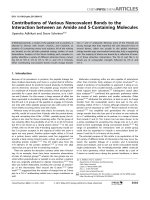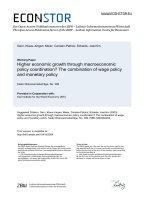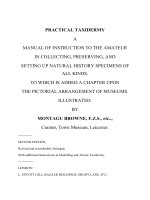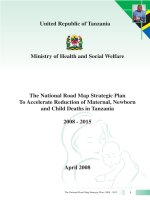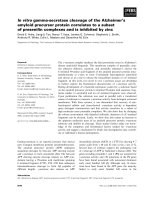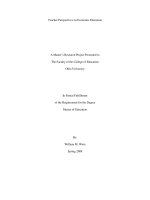Presented to the faculty of the Department of Public Policy and Administration California State University, Sacramento
Bạn đang xem bản rút gọn của tài liệu. Xem và tải ngay bản đầy đủ của tài liệu tại đây (2.11 MB, 141 trang )
UNHAPPINESS: THE HIDDEN COST OF NOT HAVING HEALTH INSURANCE
COVERAGE
A Thesis
Presented to the faculty of the Department of Public Policy and Administration
California State University, Sacramento
Submitted in partial satisfaction of
the requirements for the degree of
MASTER OF PUBLIC POLICY AND ADMINISTRATION
by
Ngan Lam Thi Tran
SPRING
2013
© 2013
Ngan Lam Thi Tran
ALL RIGHTS RESERVED
ii
UNHAPPINESS: THE HIDDEN COST OF NOT HAVING HEALTH INSURANCE
COVERAGE
A Thesis
by
Ngan Lam Thi Tran
Approved by:
__________________________________, Committee Chair
Robert W. Wassmer, Ph.D.
__________________________________, Second Reader
Edward L. Lascher, Jr., Ph.D.
____________________________
Date
iii
Student: Ngan Lam Thi Tran
I certify that this student has met the requirements for format contained in the University format
manual, and that this thesis is suitable for shelving in the Library and credit is to be awarded for
the thesis.
__________________________, Department Chair
Robert W. Wassmer, PH.D.
Department of Public Policy and Administration
iv
___________________
Date
Abstract
of
UNHAPPINESS: THE HIDDEN COST OF NOT HAVING HEALTH INSURANCE
COVERAGE
by
Ngan Lam Thi Tran
Although the United States has the highest health care spending per capita of any
industrialized country, there are over 48 million nonelderly Americans lacking health insurance
coverage, which translates to more than 18% of the nonelderly being uninsured. Currently,
governments around the world are pursuing strategies to incorporate well-being measures to
advance public policy, yet there are few studies that focus on the effects of health insurance
coverage on well-being. This study fills the gap by exploring the relationship between well-being,
health insurance coverage, health care cost, and Medicaid factors in the United States.
Data for this study come from the Centers for Disease Control and Prevention’s Behavioral
Risk Factor Surveillance System (BRFSS) 2010 survey. The BRFSS houses the world’s largest
ongoing telephone health survey system with over 350,000 adults interviewed each year. It is
designed to measure behavioral risk factors for the adult populations to identify emerging health
problems, establish and track health objectives, and develop and evaluate public health policies
and programs. In addition to the BRFSS data set, this study also uses data on states’ ranking of
Medicaid programs from a 2007 report published by the Public Citizen Health Research Group.
v
Controlling for confounding factors, results from a logistic regression analysis indicated
that individuals who could not see a doctor due to cost were 40.7% less likely to be satisfied with
life. Similarly, individuals without health insurance coverage were 9.4% less likely to be happy.
Moreover, individuals residing in states with a 1-standard-deviation-higher percentage of
Medicaid scope of services ranking and Medicaid eligibility ranking have lower odds of being
satisfied with life by 6.1% and 2.5%, respectively. However, low-income, self-employed, and
unemployed individuals residing in states with better Medicaid rankings were found to be
happier. These findings add to the existing literature by suggesting that health insurance
coverage, ability to see a doctor, and residency in states with better Medicaid rankings
substantially affect individual well-being. These effects held across income categories and health
status, which further emphasized their significant influence on happiness. Findings from this
study have major implications for where policymakers should focus their attention.
_______________________, Committee Chair
Robert W. Wassmer, Ph.D.
_______________________
Date
vi
ACKNOWLEDGEMENTS
I owe my deepest gratitude and appreciation to all those who helped me accomplish my
educational goals. There are many people I would like to thank for their support and
encouragement, without whom this thesis would not have been made possible.
First and foremost, it is with immeasurable gratitude that I acknowledge the support of my thesis
advisor, Professor Rob Wassmer, for imparting to me your knowledge about the wonder of
statistical analyses, for your much needed guidance and support to complete this thesis, and for
encouraging me to grow. Thank you for spending countless hours to mentor me through
completion, for responding to my numerous appeals for help, and for your timely and expeditious
review. I would also like to express my sincere gratitude to my second reader, Professor Ted
Lascher - without your guidance, expertise, and spirit of adventure, this thesis would not have
been possible. Additionally, I am grateful to Professor Mary Kirlin for your continued
encouragement, your “it depends” answers that helped me grasp the complexity of public policy
issues, and for shaping me into a critical thinker.
I would like to express my deepest appreciation and thanks to my colleagues and friends at
CalPERS, Ray Jacobs, John Maradik-Symkowick, Gayle Pitt, Valerie Wong, Milly RomeroSalas, Brian Covi, and Glenn Stuter, for allowing me to talk incessantly about my thesis, for your
encouragement, and for helping me with the final reviews and formatting. I am very grateful to
my managers at CalPERS, especially Stacie Walker and Kari Yoshizuka, for your ongoing
support of my educational goals and for giving me the flexibility in my work schedule to meet the
demands of graduate school.
I am grateful for the friendship of my PPA pals, Jillian Benci-Woodward, George Bravo, Ryan
Ong, Angela Marin, Sergio Aguilar, and Katie Cardenas, who watched me struggle through the
finish line during the past few years and without whose support this thesis would not have been
possible. I would be remiss if I did not also acknowledge Ms. Aline Bier, whom I am deeply
indebted to and grateful for your continued support and encouragement since my undergraduate
days at Cal – thank you for your gentle nudges to remind me the importance of higher education.
vii
I am forever indebted to my mother and grandmother for believing in my abilities and
encouraging me to attain more than they ever dreamed possible for themselves and the
tremendous sacrifices they made to provide me access to a world of educational opportunities and
infinite possibilities. Without them, I would not be the person I am today. To my little brother,
even while you struggled you were always encouraging, your love and support mean so much to
me. To my little cousin, thank you for those delicious home cooked meals that gave me the fuel to
power through furious writing sessions and for always encouraging me to keep going.
Last but definitely not least, I dedicate this thesis to my amazing husband, Eric, without whom I
would not have started or finished this program. Your inspiration, encouragement, and
unconditional love have been instrumental to my educational goals and my love of learning. You
have always been by my side to witness the highs and lows of my graduate school experience, the
lessons, struggles, and joys of learning. Thank you from the bottom of my heart for always
encouraging me to strive for more, for always challenging me to go further than the limits I have
set for myself, and for believing in me. You continue to be my true source of love and inspiration.
viii
TABLE OF CONTENTS
Page
Acknowledgements ................................................................................................................ vii
List of Tables ........................................................................................................................... xi
List of Figures ........................................................................................................................ xii
Chapter
1. INTRODUCTION……………………………………………………………………….. 1
Research Question ....................................................................................................... 3
Affordable Care Act Background ................................................................................ 4
Health Care Spending and Health Outcome ................................................................ 5
Disparities in Health Insurance Coverage and Health Care Access Across the U.S...10
The Uninsured Population ......................................................................................... 13
California’s Uninsured Population and the Projected Impact of the ACA. ................ 17
Consequences of the Uninsured ................................................................................ 20
Health Care Coverage, Health Care Cost, and Well-Being ....................................... 22
Organization of Thesis ............................................................................................... 24
2. LITERATURE REVIEW .................................................................................................. 25
Defining Happiness and Measurement Validity ......................................................... 25
Policy Implications of Happiness Research ................................................................ 27
Key Happiness Predictors .......................................................................................... 31
Health Effect on Happiness and Well-Being ............................................................. 38
Gap in Happiness and Well-Being Literature ............................................................ 41
3. METHODOLOGY ............................................................................................................ 44
Data Collection .......................................................................................................... 45
ix
Regression Model ...................................................................................................... 51
Causal Model Justification......................................................................................... 52
Data Sample ............................................................................................................... 55
4. REGRESSION RESULTS................................................................................................ 64
Multicollinearity ....................................................................................................... 65
Heteroskedasticity ..................................................................................................... 66
Ordinary Least Squares Linear Regression ............................................................... 67
Binomial Logistic Regression ................................................................................... 72
Overall Model Fit ...................................................................................................... 78
Expectations and Results .......................................................................................... 79
Interaction Variables ................................................................................................. 83
5. CONCLUSION ................................................................................................................. 89
Empirical Findings .................................................................................................... 90
Research Question Evaluation .................................................................................. 95
Policy Implications ................................................................................................... 99
Limitations of the Study and Future Research ........................................................ 105
Final Thoughts ........................................................................................................ 106
Appendix A. Table of Literature Study Methods, Data Sets, Findings, and Significance ... 108
Appendix B. Simple Correlation Coefficients and Significance ........................................ 116
References ............................................................................................................................. 124
x
LIST OF TABLES
Tables
Page
1.1
OECD Data Comparing the U.S. to 15 Comparable High-Income Countries ………. 9
1.2
State Comparison of the Uninsured, 3-Year Average 2009-2011……………..……..11
1.3
Projected Changes in Insurance Coverage in CA by 2016 as a Result of the ACA….19
3.1
Scores and Ranks for State Medicaid Programs by State…………………………….50
3.2
Variable Labels, Expected Impact, Description, and Sources………………………..56
3.3
Descriptive Statistics………………………………………………………………….60
4.1
OLS Linear Regression Model ………………………………………….………...….69
4.2
Preferred Regression Model – Binomial Logistic Regression……….……………….75
4.3
Classification Table………………………………………………………...................79
4.4
Expected and Actual Signs of Explanatory Variables………………………………...82
4.5
Logistic Regression with Significant Interactions………………………………….....84
5.1
Odds Ratios and Confidence Intervals of Significant Dichotomous Variables……….90
5.2
Odds Ratios and Confidence Intervals of Significant Continuous Variables………....92
xi
LIST OF FIGURES
Figures
Page
1.1
Per Capita Total Health Care Expenditures, 2010…………………………………… 6
1.2
National Health Expenditures (NHE) per Capita and as a Share of GDP, 19602010…………………………………………………………………………………...7
1.3
International Comparison of Spending on Health, 1980-2008………………………..8
1.4
Nonelderly Uninsured Rates by State, 3-Year Average, 2009-2011………………...12
1.5
Number and Percentage of Nonelderly without Insurance: U.S., 1978-2007………..14
1.6
Characteristics of the Nonelderly Uninsured Population, 2011……………………...15
1.7
Access to Care by Health Insurance Status, 2011……………………….…………...21
2.1
Life Satisfaction and Per Capita GDP around the World………………………….....28
2.2
Confidence in Healthcare and Medical Systems around the World………………….29
3.1
Frequency Distribution of Survey Respondents’ Life Satisfaction, 2010……………46
3.2
Health Insurance Coverage and Life Satisfaction of Respondents Aged 18-64,
2010…………………………………………………………………………………..47
3.3
Life Satisfaction and Doctor Affordability, 2010……………………………….…...48
4.1
Comparing Linear and Logistic Regression Models…………………………………73
5.1
Percentage Change in Odds of Life Satisfaction by Major Causal Factors………….99
xii
1
Chapter One
INTRODUCTION
The Declaration of Independence promised every American the unalienable rights to
“Life, Liberty and the pursuit of Happiness,” yet the idea of what makes people happy is an
elusive and ancient mystery that has captured the heart and attention of many philosophers,
economists and psychologists throughout history. Increasingly, many are recognizing that money
does not necessarily bring happiness. Robert F. Kennedy eloquently captured the short-comings
of Gross National Product (GNP) as a measure of well-being by referring to it as a mere
accumulation of material things that counts “air pollution and cigarette advertising…the
destruction of our redwood and the loss of our natural wonder in chaotic sprawl…napalm and
counts of nuclear warheads,” and yet “it measures everything in short, except that which makes
life worthwhile” (Kennedy, 1968). Given the lack of well-being measures, there is a growing
interest among governments around the world to capture the importance of happiness and wellbeing by incorporating well-being measures to advance public policy.
As of 2011, 48 million nonelderly Americans lacked health insurance coverage, which
means more than one in six, or 18% of the nonelderly were uninsured (DeNavas-Walt et al.,
2012). The Council of Economic Advisers’ (CEA) projection suggests this number would have
risen to about 72 million in 2040 in the absence of health care reform (2009). This alarming
uninsured rate among the nonelderly population exists despite the fact that health care spending
per capita in the United States (U.S.) is higher than in any other industrialized nation. Currently,
U.S. health care expenditures are about 18% of Gross Domestic Product (GDP) and projected to
rise sharply. If health care costs continue to grow at historical rates, the share of GDP devoted to
health care in the U.S. is projected to reach 34% by 2040 (Council of Economic Advisers, 2009).
2
High uninsured rates and growing health care costs make quality health care less affordable and
accessible for the low-income and minority groups that make up a disproportionate percentage of
the uninsured. This increases the disparities in health insurance coverage, health status, and health
care delivery across the nation.
Although well-being researchers are finding empirical evidence for the major well-being
predictors, there is only one study to date that focuses on the effect of health insurance coverage
on happiness and well-being even though major policy concerns stem from these issues. This
study fills the gap in well-being literature by further exploring the connection between wellbeing, health insurance coverage, and health care cost. Regression analyses are used to evaluate
the impact of health insurance coverage and health care cost in the context of recently adopted
landmark legislation, the Patient Protection and Affordable Care Act (ACA), which aims to
reduce the uninsured rate by 50%. By exploring the connection between happiness, health
insurance coverage, and health care cost, I hope to contribute depth and relevance to the existing
discussion on the evaluation of the desirability of the recent health care reform. To provide the
framework for my research, the remainder of this chapter includes a discussion of my research
question; a background on the ACA; a description of U.S. health care spending and health
outcomes; a discussion of the disparities in health insurance coverage and access to care across
the U.S.; an emphasis on California’s uninsured population and the ACA’s impact to narrow this
study’s scope of analysis to specific state level; a focus on the uninsured population and the
consequences of being uninsured; a dialog that circles back to the probable impact of health care
coverage and health care cost on well-being to emphasize the significance of my research
question; and lastly, a brief description of the remaining chapters in this study.
3
Research Question
Unquestionably, health insurance coverage and health care cost have a significant impact
on access to health care, health status, and presumably well-being. Lack of health insurance
coverage and rising health care cost lead to limited access to health care, which could adversely
impact an individual’s health. Since health is a robust indicator of well-being, lack of health
insurance coverage is likely to also affect well-being. Even if individuals do not get sick, the
psychological and financial stress from worrying what would happen if they do get sick can be
detrimental. The uninsured are less likely to receive preventive care and services for major health
conditions and chronic diseases, and as a result, many suffer serious health and financial
consequences. Low-income individuals make up a disproportionately large percentage of the
uninsured and health insurance is extremely expensive relative to their incomes, therefore the
well-being of these individuals is likely to be substantially impacted. While we presume health
insurance coverage and health care cost have an impact on well-being, this effect has not been
precisely defined or measured in previous well-being studies. This study bridges the gap by
measuring the direct effect of health insurance coverage and health care cost on well-being, thus
providing a glimpse of the magnitude of the ACA health care coverage expansion’s potential
effect on our nation’s overall happiness. The benefits of health care coverage, reduced health
inequities, and improved overall health outcomes of the population may be much greater than the
additional cost required to support the health care expansion. The ACA’s central goal is to reduce
the number of uninsured individuals in the U.S. Understanding the impact of health insurance
coverage on happiness would illuminate the ACA’s potential impact on our nation’s well-being.
Furthermore, I plan to analyze the impact of health insurance coverage across states to determine
whether health insurance coverage and health care cost’s impact on the well-being of the poor is
greater in states with less generous Medicaid benefits.
4
Affordable Care Act Background
On March 23, 2010, President Obama signed the ACA into law, the most significant and
comprehensive health care reform since the passage of Medicare and Medicaid in 1965. Although
the ACA already required health plans and insurers to cover individuals regardless of their health
status, effective January 1, 2014, the ACA also requires health plan providers to cover a
minimum set of services known as the Essential Health Benefits and mandates that most
individuals obtain health care coverage or pay a penalty. In addition, the ACA is expected to
reduce the uninsured rate by over 50% by expanding Medicaid, providing subsidized private
coverage for individuals with incomes up to 400% of the federal poverty level (FPL), and
reforming the health insurance marketplace (Congressional Budget Office, 2012). The
Congressional Budget Office (CBO) estimated that by 2022, 38 million new individuals would
have health coverage, with 12 million through Medicaid and 26 million through the ACA’s health
insurance exchanges (2013).
To expand coverage, the ACA provides for: (1) the health insurance exchange, a new
marketplace in which individuals who do not have access to public coverage or affordable
employer coverage can purchase insurance and access federal tax credits, and (2) two expansions
of Medicaid – a mandatory expansion by simplifying rules affecting eligibility, enrollment, and
retention; and an optional expansion to adults with incomes up to 138% of the FPL. The CBO
estimated that the insurance coverage provisions of the ACA would have a net cost of $1.168
trillion over the 2012-2022 period, which accounted for the recent Supreme Court decision that
made the Medicaid expansion program optional for states (CBO, 2012). This provision of the
Supreme Court decision is estimated to result in 3 million more people being uninsured than the
previous estimate under the ACA (CBO, 2012). Overall, the CBO estimated that the ACA would
cost about $1.3 trillion over the next 10 years. Despite its cost, the law will reduce the federal
5
budget deficit because it contains provisions for revenue and cost saving measures to offset the
increased costs (CBO, 2013).
Health Care Spending and Health Outcome
The U.S. health system and health care delivery is extremely fragmented, with limited
public health resources and a large uninsured population. Compared to people in Organisation for
Economic Co-operation and Development (OECD) countries, Americans are more likely to find
care inaccessible or unaffordable and to report lapses in the quality and safety of care outside of
hospitals (National Research Council et al., 2013). Despite its powerful economy, the U.S. has
higher rates of poverty and income inequality than most high-income countries, with Americans
having less access to “safety net” programs that help buffer the effects of adverse economic and
social conditions. Only three OECD countries – Chile, Mexico, and Turkey – provide less health
care coverage than the U.S. (National Research Council et al., 2013). What makes the U.S.
distinctive is unlike its high-income counterparts, the U.S. does not provide universal or nearuniversal health insurance coverage, despite spending more per person on health care than any
other developed country. Figure 1.1 below, shows the U.S.’ health spending per capita in 2010
was 53% higher than the next highest spending country (Norway) and about 152% higher than
the OECD average (OECD, 2013).
6
Figure 1.1: Per Capita Total Health Care Expenditures, 2010
Portugal
$2,728
Italy
$2,964
Spain
$3,056
Finland
$3,251
OECD Average
$3,265
United Kingdom
$3,433
Sweden
$3,758
France
$3,974
Germany
$4,338
Austria
$4,395
Canada
$4,445
Denmark
$4,464
Switzerland
$5,270
Norway
$5,388
United States
$8,233
$0
$1,000 $2,000 $3,000 $4,000 $5,000 $6,000 $7,000 $8,000
Source: Total expenditure on health per capita at current prices and PPPs in U.S. dollars.
OECD, 2013.
Since 1950, health care spending more than tripled as a percentage of GDP, with the U.S.
government accounting for almost half of all health care spending in the nation (Gruber, 2008;
Council of Economic Advisers, 2009). In 1970, total health care spending was about $75 billion,
or only $356 per person. In less than 40 years, these costs have grown to $2.6 trillion, or $8,402
per person (see figure 1.2 below). As a result, the share of economic activity devoted to health
care grew from 5.2% in 1960 to 17.9% in 2010 and is projected to reach one-fifth of GDP by
2020 (Kaiser Family Foundation, 2012a).
7
Figure 1.2: National Health Expenditures (NHE) per Capita and as a Share of GDP, 1960-2010
Source: Kaiser Family Foundation, 2012a.
Several sources attributed high health care costs to the inefficiency of the U.S. health care
system with payment systems that reward medical inputs rather than outcomes, high
administrative costs, and inadequate focus on disease prevention. Compared to 11 other OECD
countries from 1998 to 2008, U.S. health care spending growth has considerably surpassed that of
other countries, both per capita and as a percentage of GDP (see Figure 1.3 below).
8
Figure 1.3: International Comparison of Spending on Health, 1980-2008
Source: Squires, D. (2011) - OECD Health Data 2010.
Note: PPP=purchasing power parity, an estimate of the exchange rate required to equalize the
purchasing power of different currencies, given the prices of goods and services in the
countries concerned.
Although the U.S. health system is the most expensive in the world, comparative analyses
indicate its consistent underperformance relative to other countries. Compared to Australia,
Canada, Germany, the Netherlands, New Zealand, and the United Kingdom, the U.S. ranked last
in the categories of access, patient safety, coordination, efficiency, and equity (Davis, K, et al.,
2010). Furthermore, the U.S. ranked at or near the bottom in nine key health indicators: chronic
lung disease, drug-related deaths, general disability, heart disease, injuries and homicides, low
birth weight, teen pregnancy and sexually transmitted infections, obesity, and diabetes (National
Research Council and Institute of Medicine, 2013). Lack of access to health insurance, higher
poverty levels, and overeating are among the causes of lower health and shorter life spans among
U.S. residents (National Research Council et al., 2013). Between 10 to 50% of U.S. deaths were
9
estimated to occur due to insufficient medical care, while 98,000 lives are claimed each year due
to medical errors, such as miscommunications, flawed handoffs, and confusion, resulting in gaps
and delays in the delivery of care (National Research Council & Institute of Medicine, 2013).
Table 1.1 below shows the U.S., compared to other high-income countries, have the
lowest life expectancy, highest infant mortality rate, highest potential years of life lost due to all
causes, highest obesity rate, and is among the countries with the lowest physician density per
1,000 population in 2010 (OECD, 2013).
Table 1.1: OECD Data Comparing the U.S. to 15 Comparable High-Income Countries
Source: OECD, 2013.
10
Disparities in Health Insurance Coverage and Health Care Access Across the U.S.
Enacted in 1965 and jointly financed by states and the federal government, Medicaid is
the nation’s health and long-term care coverage program for over 60 million low-income and
high-need Americans (Snyder, et al., 2012). Federal law requires states to cover certain
mandatory eligibility groups, including qualified parents, children, and pregnant women with low
income, as well as older adults and people with disabilities with low income. Each state
establishes and administers its own Medicaid program. Although states must cover certain
mandatory benefits, each state has significant flexibility to expand beyond program minimums
for benefits and coverage, to determine how care is delivered, and to determine what and how
providers are paid. As a result, there is tremendous variation across the states in Medicaid
spending, with no evidence of corresponding variations in either medical needs or outcomes.
Taking state population into account, Medicaid spending per state resident varied from a
low of $471 in Nevada to a high of $2,595 in the District of Columbia. Medicaid spending per
enrollee ranged from a low of $3,527 in California to a high of $9,577 in Connecticut (Snyder, et
al., 2012). Across the states, there was nearly a 20-fold difference in eligibility standards for
parents, ranging from 11% of FPL in Alabama to 215% of FPL in Minnesota (Courtot, B. &
Coughlin, T, 2012). States with a lower uninsured rate were found to have more generous
eligibility requirements for Medicaid and other public health insurance programs (Brown, et al.,
2000). Table 1.2 below lists states with the highest uninsured rate and states with the lowest
uninsured rates.
11
Table 1.2: State Comparison of the Uninsured, 3-Year Average 2009-2011
States with the Highest
Percentage of Uninsured
Residents
% Uninsured
Texas
27.0
Florida
24.8
Nevada
24.3
New Mexico
23.9
Georgia
21.8
South Carolina
21.8
California
21.6
States with the Lowest
Percentage of Uninsured
Residents
% Uninsured
Massachusetts
5.1
Hawaii
8.8
Minnesota
10.3
Vermont
10.5
Wisconsin
11.1
Connecticut
11.6
Maine
11.6
Source: Employee Benefit Research Institute, 2012.
The likelihood of being uninsured varies by states due to differences in employment,
share of families with low incomes, and public insurance program eligibility levels. Figure 1.4
below shows uninsured rates vary more than five-fold across states ranging from 5% in
Massachusetts to 27% in Texas, with states in the South and West having some of the highest
uninsured rates.
12
Figure 1.4: Nonelderly Uninsured Rates by State, 3-Year Average, 2009-2011
Source: California Healthcare Foundation, 2012.
The ACA Medicaid expansion efforts will help narrow the disparity gap of Medicaid
benefits and uninsured rates across the states. Although the June 2012 Supreme Court ruling
made Medicaid expansion to individuals with incomes up to 138% of the FPL optional for states,
many states plan to expand Medicaid eligibility for their residents since the federal government
will pay most of the ACA Medicaid expansion expenses. States that do not implement the
expansion will forgo significant federal funding.
If all states implement the ACA Medicaid expansion, state Medicaid spending between
the years 2013-2022 is projected to increase by $76 billion or less than 3%, while federal
Medicaid spending would increase by $952 billion or 26% (Holahan, et al., 2012). States’ cost of
13
implementing the Medicaid expansion is relatively small compared to the total states’ Medicaid
spending, with the federal government paying 93% of the cost. If all states implement the ACA
Medicaid expansion, an estimated additional 21.3 million people would enroll in Medicaid by
2022, a 41% increase compared to projected levels without the ACA. This would reduce the
number of uninsured by 48% (Holahan, et al., 2012). If no states expand Medicaid, Medicaid
enrollment would rise by 5.7 million people, and the number of uninsured would drop by 28%
due to increased participation from other ACA provisions (Holahan, et al., 2012). Under given
total Medicaid costs with a conservative estimate of $18 billion in state and local savings on
uncompensated care, the Medicaid expansion would save states a total of $10 billion over 20132022 (Holahan, et al., 2012).
The Uninsured Population
Non-elderly adults (individuals between 18 and 64 years old) make up a disproportionate
share of the uninsured population. They are not eligible for Medicare, which is available only to
seniors, and are less likely than children to be eligible for Medicaid. Of this group, approximately
56% receive health insurance through employer-sponsored insurance, 20% through Medicaid or
other public health programs, 6% through private, non-group markets, and 18% remain uninsured
(Kaiser Family Foundation, 2012b). Since 1990, the percentage of nonelderly people without
coverage remained stable, but in 2007, the number of uninsured individuals increased by more
than six million, to 43.3 million (DeNavas-Walt, et al., 2012) (see figure 1.5 below). During this
period, the percentage of private health insurance coverage continued to decline, while the
percentage with Medicaid coverage increased. Over the past eleven years, Medicaid coverage has
partially offset declining employer-sponsored insurance, but not enough to prevent continued
growth in the uninsured population. While 80% of the insured (i.e. 177.8 million people) have
coverage through private insurance, only 10% are purchased through private, non-group plans
